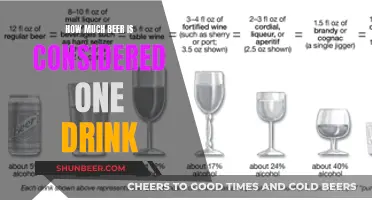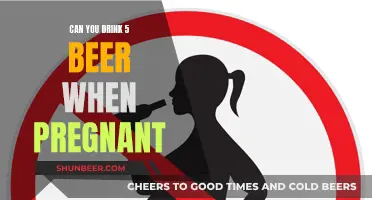
The tax system can be a complex and confusing topic, but it can be simplified using the metaphor of beer. Imagine a group of ten men who go out for drinks every week. Each night, they share a bill of $100, but they don't split it evenly. Instead, they pay according to their income tax brackets, with the richest man paying the most at $59, and the poorest four men paying nothing. One day, the bar owner decides to reduce their bill by $20 as a reward for their loyalty. The group still wants to pay their bill according to their tax brackets, but they're unsure how to divide the remaining $80 fairly. This scenario illustrates how progressive tax systems work and how tax cuts can benefit those in higher tax brackets.

The progressive tax system
Progressive tax systems are designed to ensure that those with higher incomes contribute more to the collective pot. This is often illustrated with the metaphor of beer.
Imagine ten men go out for a beer once a week and the bill comes to $100. The men decide to split the bill according to how income taxes are calculated. The four poorest men pay nothing, the fifth poorest pays $2, the sixth pays $5, the seventh pays $8, the eighth pays $13, and so on, with the richest man paying $53. This is a progressive tax system in action, with each person's contribution linked to their relative wealth.
Now, suppose the bar owner decides to reduce the cost of their weekly beer by $20 as a reward for their custom. The first four men are unaffected and still drink for free. The remaining six men must now decide how to divide the $20 saving fairly. They realise that if they simply divide the saving by six, the fifth man will end up being paid to drink his beer. The bar owner suggests that it would be fairer to reduce each bill by a higher percentage for the poorer men, following the principle of the progressive tax system they had been using.
As a result, the fifth man now pays nothing (a 100% saving), the sixth man pays $3 instead of $5 (a 40% saving), the seventh man pays $6 instead of $8 (a 25% saving), the eighth man pays $10 instead of $13 (a 23% saving), the ninth man pays $15 instead of $19 (a 21% saving), and the tenth man pays $46 instead of $53 (a 13% saving). Each of the last six men is better off than before, and the first four continue to drink for free.
However, once outside the bar, the men begin to compare their savings. The sixth man points out that while he only saved $2, the tenth man saved $7. The other paying customers agree, and the first four chime in, complaining that they didn't get anything at all from the new arrangement. Feeling uncomfortable with the negative attention, the tenth man decides to stop joining the group for their weekly drinks. The following week, the nine men realise that they don't have enough money between them to pay for even half of the bill!
This story illustrates how progressive tax systems work and the potential consequences of reducing taxes. Those who pay the highest taxes stand to gain the most from a tax reduction. However, it's important to remember that everyone's experience with the tax system is different, and perceptions of fairness can vary depending on one's perspective.
Beer Batters: How Do They Work?
You may want to see also

How tax cuts work
Suppose ten men go out for a beer every day, and the bill for all ten comes to $100. If they paid their bill the way we pay our taxes, it would go something like this: the first four men (the poorest) would pay nothing. The fifth would pay $1. The sixth would pay $3. The seventh would pay $7, and so on, with the tenth man (the richest) paying $59.
The ten men drank in the bar every day and were happy with this arrangement until the owner reduced their bill by $20 as a reward for their loyalty. Now, their drinks cost just $80. The first four men still paid nothing, but how could the other six divide the $20 saving so that everyone got their "fair share"?
The bar owner suggested that it would be fair to reduce each man's bill by a higher percentage the poorer he was, following the principle of the tax system they had been using. So, the fifth man now paid nothing, a 100% saving. The sixth man paid $2 instead of $3 (a 33% saving). The seventh man paid $5 instead of $7 (a 28-29% saving). The eighth man paid $9 instead of $12 (a 25% saving). The ninth man paid $14 instead of $18 (a 22% saving). The tenth man paid $46-$50 instead of $53-$59 (a 13-15% saving).
Each of the six paying customers was better off than before, and the first four continued to drink for free. However, once outside the bar, the men began to compare their savings. The fifth man pointed out that he only saved $1-$2, while the tenth man saved $7-$10. The sixth man exclaimed that it was unfair that the tenth man got three to nine times more benefit than him. The seventh man agreed, stating that the wealthy get all the breaks. The first four men joined in, yelling that the new tax system exploits the poor.
The nine men then surrounded the tenth and beat him up. The next day, the tenth man didn't show up for drinks, so the nine sat down and had their beers without him. But when it came time to pay the bill, they didn't have enough money between them for even half of the bill!
And that is how tax cuts work. The people who already pay the highest taxes will naturally benefit the most from a tax reduction. If they are taxed too much or attacked for their wealth, they may leave and take their business elsewhere, resulting in a loss of revenue for the bar or state.
The Chemistry of Beer: How It Works and Why It Matters
You may want to see also

Tax brackets
For the 2024 tax year, there are seven federal income tax brackets: 10%, 12%, 22%, 24%, 32%, 35%, and 37%. These brackets are adjusted annually to account for inflation, ensuring that taxpayers don't end up in higher brackets due to rising living costs. The income thresholds for each bracket vary depending on filing status: single, married filing jointly, married filing separately, or head of household.
Understanding tax brackets is crucial for financial planning. For instance, knowing your tax bracket can help you decide whether to take on overtime work or a second job, as it will impact the amount of tax you pay on that additional income. Additionally, tax deductions can reduce your taxable income, potentially lowering the amount of tax you owe.
Beer Gas: How Does It Work?
You may want to see also

Tax reductions
In the context of the beer analogy for the tax system, tax reductions can be understood as follows:
Suppose the same group of 10 men goes out for beer, and their bill amounts to $100. The first four men, being the poorest, pay nothing. The fifth pays $1, the sixth $3, the seventh $7, the eighth $12, the ninth $18, and the tenth man, who is the richest, pays $59. Now, imagine that the bar owner decides to reduce their daily beer cost by $20, bringing their total bill down to $80.
To maintain fairness, the bar owner suggests reducing each man's bill by a roughly equal amount. As a result, the fifth man now joins the first four in paying nothing. The sixth man's bill is reduced from $3 to $2, a 33% savings. The seventh man's bill goes down to $5, a 28% savings. The eighth man pays $9 instead of $12, saving him 25%. The ninth man's bill is now $14, a 22% reduction, and the tenth man pays $49, saving him $10 or 16% of his original bill.
While each of the six paying customers enjoys a reduction in their bill, they begin to compare their savings outside the restaurant. They notice that while some saved a small amount, the tenth man, who pays the most in absolute terms, benefited the most from the reduction, receiving a $10 discount. This observation leads to dissatisfaction and complaints about the system benefiting the wealthy more than the poor.
In reality, when taxes are reduced, those who pay higher taxes in absolute terms tend to benefit the most. This can lead to a perception of unfairness, as illustrated in the beer analogy, where the highest taxpayer received the greatest benefit from the tax reduction. However, it's important to remember that everyone's relative savings are the same, and the absolute savings differ due to the larger initial tax burden.
In the case of the beer industry, tax reductions can have a significant impact on brewers and importers. For instance, the Tax Cuts and Jobs Act in the US provided a reduction in federal excise taxes, which was made permanent at the end of 2020. This move provided relief to an industry that supports millions of American jobs and generates billions in economic activity. Similarly, in Canada, the beer industry has pushed for reductions in federal tax increases, arguing that lower taxes would benefit struggling brewers and consumers.
Pizza Hut's Beer Delivery: How Does It Work?
You may want to see also

Tax evasion
In the United States, tax evasion is a criminal offence. According to the Internal Revenue Code, Title 26, Subtitle E, Chapter 51, Subchapter J, Part III, §5671, anyone who evades or attempts to evade the tax imposed by section 5051, or with the intent to defraud the United States, fails or refuses to keep and file true and accurate records and returns as required by section 5415, shall be subject to penalties.
The penalties for tax evasion can include a fine of up to $5,000, imprisonment of up to 5 years, or both, for each offence. Additionally, the offender shall forfeit all beer made by or for them, as well as all the vessels, utensils, and apparatus used in the brewing process.
It is important for businesses and individuals involved in the beer industry to comply with tax requirements and keep accurate records to avoid penalties and legal consequences. Tax evasion is a serious offence that can result in significant financial and legal repercussions.
To ensure compliance with tax regulations, it is advisable to seek professional advice and stay informed about the latest tax laws and requirements. By understanding and fulfilling their tax obligations, businesses and individuals can contribute fairly to the tax system and support the funding of essential government services.
The Process of Canning Beer: A Step-by-Step Guide
You may want to see also
Frequently asked questions
The tax system can be explained using a beer analogy. Suppose 10 men go out for a beer every day and their bill amounts to $100. The first four men, being the poorest, pay nothing. The fifth pays $1, the sixth $3, the seventh $7, the eighth $12, the ninth $18, and the tenth man, who is the richest, pays $59. One day, the bar owner decides to reduce their bill by $20 as they are good customers. Now the first four men still pay nothing, but how should the remaining $20 be divided among the other six so that everyone gets their fair share? The bar owner suggests that each man's bill should be reduced by a higher percentage the poorer he is, following the principle of the tax system they had been using. As a result, the fifth man now also pays nothing, the sixth man pays $2, the seventh $5, the eighth $9, the ninth $14, and the tenth $49. Although everyone is better off than before, the men begin to compare their savings outside the bar, with the sixth man pointing out that while he only saved $1, the tenth man saved $10. They conclude that the system exploits the poor and beat up the tenth man. The next day, the tenth man doesn't show up for drinks, and the remaining nine realize that they don't have enough money between them to pay for even half the bill. This is how our tax system works – those who pay the highest taxes benefit the most from tax reductions.
The current tax system is progressive, meaning that tax rates increase as the taxable amount increases. This means that those in higher tax brackets end up paying a larger proportion of their income in taxes compared to those in lower tax brackets. In the beer analogy, this would be equivalent to the richest man paying a higher absolute and relative amount for his beer compared to the others. While this system aims to reduce the tax burden on lower-income individuals, it can also create a disincentive for those in higher tax brackets to continue earning at the same level, as they may feel they are being unfairly targeted.
One suggestion to improve the tax system could be to implement a flat tax rate, where everyone pays the same percentage of their income in taxes, regardless of their earnings. This would ensure that everyone contributes proportionally to the tax system and may encourage economic growth by providing an incentive for people to work harder and earn more, knowing that they will get to keep a larger proportion of their income. However, critics of the flat tax argue that it would place a disproportionate burden on lower-income individuals, who may struggle to pay the same percentage of their income as high-income earners.







